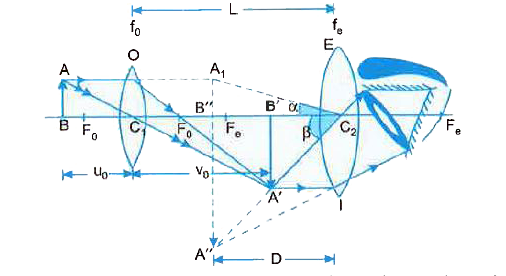(a) Draw a ray diagram for final image formed at distance of distinct vision (D) by a comppound microscope and write expression for its magnifying power.
(b) An angular magnification (magnifying power) of 30x is desired for a compound microscope using as objective of focal length 1.25 cm and eye piece of focal length 5 cm. How will you set up the compound microscope?
(a) The labelled ray diagram showing image formation in a compound microscope has been shown here.
Magnifying power of a travelling microscope is given by the relation :
m=v0u0(1+Dfe)=Lf0(1+Dfe)

(b) In normal adjustment of microscope, the final image is formed at the least distance of distinct vision i.e., D = 25 cm. In that case, angular magnification of eyepiece
me=(1+Dfe)=1+255=6 [∵fe=+5cm]
As magnification of microscope m = 30 and m=m0×me
⇒ m0=mme=306=5
∴ m0=v0u0=5
or v0=5u0 and as per sign convention u0 is −ve but v0 is +ve and f0=+1.25cm.
Hence, we have
1v0−1u0=1f0or15u0−1(−u0)=11.25or65u0=11.25
⇒ u0=1.5cm and hence |v0|=|5u0|=7.5cm
Moreover me=∣∣∣veue∣∣∣=D|ue|, hence |ue|=Dme=256=4.17cm
∴ Separation between the objective and eye-lens L=|v0|+|ue|=7.5+4.17=11.67cm and the object should be placed 1.5 cm from the objective lens to obtain the desired magnification.
Topper's Solved these Questions
- CBSE SAMPLE QUESTION PAPER 2019-20 (SOLVED)BOOK - U-LIKE SERIESCHAPTER - CBSE SAMPLE QUESTION PAPER 2019-20 (SOLVED)EXERCISE - SECTION C
8 Videos
- CBSE EXAMINATION PAPER 2020 (SOLVED) BOOK - U-LIKE SERIESCHAPTER - CBSE EXAMINATION PAPER 2020 (SOLVED) EXERCISE - SECTION - D
6 Videos
- CURRENT ELECTRICITY BOOK - U-LIKE SERIESCHAPTER - CURRENT ELECTRICITY EXERCISE - SELF ASSESSMENT TEST (SECTION C )
3 Videos
Similar Questions
(a) Draw a ray diagram for final image formed at distance of distinct vision (D) by a compound microscope and write expression for its magnifying power.
(b)An angular magnification (magnifying power) of 30x is desired for a compound microscope using as objective of focal length 1.25cm and eye piece of focal length 5cm. How will you set up the compound microscope?
View SolutionAn angular magnification (magnifying power) of 30X is desired using an objective of focal length 1.25cm and an eye piece of focal length 5cm. How will you set up the compound microscope ?
View Solution
Knowledge Check
The magnifying power of a microscope with an objective of 5mm focal length is 400. The length of its tube is 20cm. Then the focal length of the eye− piece is
A200cmB160cmC2.5cmD0.1cm
An angular magnification (magnifying power) of 30X is desired using an objective of focal length 1.25cm and an eye piece of focal length 5cm. How will you set up the compound microscope ?
View SolutionAn angular magnification (magnifying power) of 30 X is desired using an objective of focal length 1.25 cm and an eyepiece of focal length 5 cm. How will you set up the compound microscope ?
View SolutionAn angular magnification (magnifying power) of 30X is desired using an objective of focal length 1.25cm and an eye piece of focal length 5cm. How will you set up the compound microscope ?
View SolutionThe magnifying power of a microscope with an objective of 5mm focal length is 400. The length of its tube is 20cm. Then the focal length of the eye− piece is
View Solution(a) Draw a ray diagram to show the working of a compound microscope. Deduce an expression for the total magnification when the final image is formed at the near point.
(b) In a compound microscope, an object is placed at a distance of 1.5 cm from the objective of focal length 1.25 cm. If the eyepiece has a focal length of 5 cm and the final image is formed at the near point, estimate the magnifying power of the microscope
View SolutionDraw a ray diagram to show the working of a compound microscope. Deduce an expression for the total magnification the final image is formed at the near point.
In a compound microscope , an object is placed at a distance of 1.5 cm from the objective of focal length 1.25cm. if the eye piece has a focal length of 5 cm and the final image is formed at the near point, estimate the magnifying the power of the microscope.
View SolutionLeast distance of distinct vision is 25 cm . Magnifying power of simple microscope of focal length 5 cm is
View Solution
